

Herriman
Councilmember Shields resigns from District 4
By Elisa Eames | e.eames@mycityjournals.com
First elected in 2020, Herriman’s Steven Shields has resigned from the city council to pursue job opportunities out of state.
On April 24, Herriman City announced the resignation of District 4 City Councilman Steven Shields, though Shields had already announced plans to leave on Facebook in late March.
“Some things precipitated last summer that led to some career changes for me… [and] I have a really incredible opportunity in the Houston area,” Shields said. “But once you move outside of the district boundaries, it’s kind of a forced resignation… I have very mixed emotions.”
Shields, who works in sales strategy, business coaching and business development, has been working with his family to transition to Texas since March.
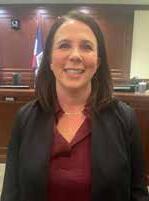
Nearly six years ago, the former councilman was a reluctant contender for a spot on the city council. “I’d never aspired to become a city council person or to be an elected official. I honestly didn’t really give a lot of attention to things that were going on in the city.”
Until he got wind of the Olympia development, that is.
Dismayed, Shields heard about the project only three days prior to the original county vote. “It was kind of a crisis of conscience, and I felt like I needed to be more informed and more involved,” he said. “And frankly, if you talk to most of the council members, that’s how they ended up getting to where they are today.”
After the Olympia vote, Shields began attending com -
Thank You
to our Community Sponsors for supporting City Journals

munity and city council meetings and speaking with city council members to stay informed. But it wasn’t until his neighbors suggested he run for city council himself that the idea even occurred to him.
“At first, I dismissed it out of hand,” he said. “And then eventually, I had the opportunity to throw my hat in the ring.” Shields began his first term in January of 2020 and was reelected in 2024.
When he took office, approximately 35-40% of the city’s general fund budget was supported by one-time fees, such as building permits, and relationships between the city council, city management and the development community had broken down. “There was a lot of contention…
and the budget was kind of out of whack,” Shields said.
This all took place just as Herriman emerged from a period of tremendous growth. “From 2010 to 2020, Herriman was the fastest-growing city in the United States,” Shields said. “It was unparalleled.” Over 30,000 new residents settled in Herriman over 10 years—and then COVID hit, further complicating everything.
Satisfied with his part in bringing the city to where it is today, Shields has worked to repair relations between the city, the council and the community, attract highly-qualified city personnel, including police officers, and find more long-term revenue sources.
“The city’s finances have been separated so that ongoing expenses are funded only with ongoing revenues. And vice-versa—one-time expenses are funded through one-time revenues,” Herriman Communications Manager Jonathan LaFollette said.
“I’m super proud of what we’ve done in the past five and a half years,” Shields said. “I feel like I’m leaving it in good hands, and I can say that I feel like I did something good during the time I was here.”
With just one month to appoint a replacement after Shields’ resignation, the city collected appointee candidate applications, which were due May 8. The city council then interviewed candidates at a public meeting on May 15 to fill the vacancy for the duration of 2025. Long-time resident Terrah Anderson was appointed as the interim council member.
Only appointee candidates who live in Herriman’s District 4, are registered to vote in Herriman, are free of felony and other convictions and have lived in the city for the last 12 months were considered. Candidates also paid a $25 filing fee.
The city’s general election in November will include a special election for Shields’ seat for 2026 and 2027; his term continues through 2027. “The candidate filing period [for the special election] begins June 2 during regular business hours and ends on June 6 at 5:00 p.m. Declaration of Candidacy Forms or Nomination Petitions must be filed in person with the City Recorder at 5355 W. Herriman Main Street, Herriman,” the city’s website says. l


Former Councilman Steven Shields, his wife Lindsay and their two children will move to Texas this summer. (Photo courtesy Steven Shields)
Herriman resident Terrah Anderson was appointed to fill the council seat for the rest of this year. (Elisa Eames/City Journals)

Salt Lake County
801-840-4000 Sandy & Salt Lake City
801-799-3000


DATES FOR LEGAL DISCHARGE
: July 2-5 | July 22-25
*If you live in a restricted area, it is illegal to discharge fireworks anytime
TIMES
*On July 4 & July 24 time of discharge is extended to 12:00 midnight




Enjoy a Safe, Healthy, Active Summer
By Vincent Giron, DO
With summer here and everyone wanting to spend time outdoors and to be more active, there are four important health and safety tips that I recommend for all age groups and activity levels.
1. Stay hydrated. The No. 1 priority for summer safety is proper hydration before and after activity. Drinking lots of water and reducing the amount of caffeinated drinks is crucial for hydration. Adding electrolytes such as sports drinks is also helpful while avoiding excess sugar. Zero sugar or diet electrolyte sports drinks and hydration packs are an easy way to do this.
2. Use sunscreen. Sunscreen is crucial not only for skin health but can help with hydration as well. Sunburns put you at higher risk for dehydration. Applying sunscreen and reapplying frequently especially while swimming, playing sports, and hiking keeps your skin healthy and protected. Being conscientious about sun exposure helps prevent skin cancer, wrinkles, skin
discolorations and will help to keep your skin looking and feeling young.
3. Wear a helmet. Summer is a great time to go outdoors riding bikes, scooters and other fun activities while getting exercise. But anytime we bike, scoot, skate or participate in any riding activity, it is imperative to wear a helmet. No matter how short your ride is, you need to protect your brain. It only takes one fall or accident to cause permanent brain damage or life-long disability.
4. Stretch. People of all ages and activity levels from youth sports to the weekend warrior need to be stretching before and after activity. In the summer it is easy to skip the warm-up when exercising or playing sports because the warmer temperatures make us feel ready to go; however our muscles are still tight and are just as prone to injury as in the colder months. Taking the time to warm up by gradually stretching our muscles not only helps prevent injury but promotes muscle building and endurance. Stretching is especially im-


portant for elderly individuals. Stretching also helps reduce aches and pains as well as improve mobility and stability, which decrease the risk of falls.
Exercise is important for all ages. Summer is a great time to increase your level of activity. Exercise, especially outdoors, promotes physical as well as mental health and wellbeing. I hope we can all get outside, spend time with family and friends, and most of all, stay safe and healthy!
Dr. Vincent Giron is a CommonSpirit Health family medicine physician specializing in sports medicine. He is accepting new patients. His clinic is located at CommonSpirit Primary Care & Sports Medicine West Valley at 3336 S. 4155 W., Ste. 102 in West Valley. Phone:801-964-3925. He accepts most insurances.
Learn more about the services, care providers and missiondriven work of the Holy Cross hospitals and CommonSpirit Health at www.holycrossutah.org.


At CommonSpirit Health, we make the healing presence of God known in our world by improving the health of the people we serve, especially those who are vulnerable, while we advance social justice for all.

minutes count, count on our emergency care.
Get to know us before you need us.
When you need emergency care fast, the closest emergency room is a smart thing to know. You never know the level of care you’ll need when an emergency happens and choosing the right ER can make all the difference. And a hospital ER comes with the confidence of additional services right on-site.
Congratulations to CommonSpirit Holy Cross Hospital – Jordan Valley for receiving the Leapfrog Hospital Safety Grade-A Accreditation for the fourth consecutive time. Leapfrog Hospital Safety Grades are determined based on a rigorous assessment of various safety measures.
Find emergency care close to you at mountain.commonspirit.org
711).
Dr. Vincent Giron, DO CommonSpirit Primary Care & Sports Medicine West Valley
Virtual fieldtrips, robotics and AI, oh my
Three local teachers are leading the way in education innovation.
By Jet Burnham j.burnham@mycityjournals.com
TheUtah Coalition for Educational Technology recognized one teacher from each school district and charter school for their use of new or novel teaching practices that contribute to student learning.
Three local teachers received an Innovative Teacher Award: Krista Gibbons from Kelsey Peak Virtual Middle School, Robert Machol from Itineris Early College High School, and Crystal Van Ausdal from Mountain Heights Academy Charter School. They were recognized for their use of alternative tools to allow for innovative and tech-based projects that address real-world issues and encourage students to develop critical thinking, computer and AI skills.
Krista Gibbons, Kelsey Peak Virtual Middle School
“Innovation in the classroom is vital,” Gibbons said. “I think we should always be changing and adapting to best teach our students in the way that makes sense to them.”
As a full-time teacher and digital coach at Kelsey Peak Virtual Middle School, Gibbons has more options in her digital toolkit than most teachers to engage her students.
“I’m in a virtual school—I’m not constrained to the four walls that I would be in an actual classroom, so why not take them on a digital 360 tour of museums when I’m talking about different things and letting them see it?” Gibbons said.
Gibbons said virtual fieldtrips, such as to the Gettysburg Battlefield, are engaging and improve students’ learning.
When she can’t find the resources she’s looking for on YouTube or Nearpod, she visits Fort Bridger, Promontory Point, Goblin Valley and famous Civil War Sites to record her own footage. This summer she will film parts of the Oregon Trail and Pony Express route. She is also working with some German museums to arrange virtual tours.
Gibbons also uses a variety of tools to allow students to interview historical figures, create escape rooms based on historical events and make interactive maps of famous battles or movements.
Robert Machol, Itineris Early College High School
Computer science teacher Robert Machol uses hands-on activities to make programming classes at Itineris Early College
High School more engaging. Administrator Rabecca Cisneros said Machol is a pioneer of creative instruction, actively working to make tech and computer science classes more equitable, inclusive and fun for all students.
“He uses emerging technologies to design engaging, student-centered learning experiences that go beyond traditional curriculum,” Cisneros said.
Machol uses an unconventional method to teach computer programming, traditionally a tedious course, by using robotics. Students learn increasingly complex programming principles to get their robot to complete certain tasks or navigate obstacle courses.
He said traditional computer science classes work exclusively on a computer but he tries to get kids off the computers as much as possible, and instead moving around and doing handson kinesthetic learning.
“I think just the hands-on experience of doing these things makes it a joy to do,” he said. “It doesn’t feel like it’s a chore. They’re having fun and they’re learning on the side. It’s not a bunch of kids sitting and staring at a computer, so I think that is why it is more inclusive for lots of different learning styles.”
Machol is always looking for tech tools to use for school and personal tasks.
“There’s so much out there it’s impossible to stay on top of everything, but I’m always looking for new ways to do things,” Machol said.
Crystal Van Ausdal, Mountain Heights Academy Charter School
It is Crystal Van Ausdal’s job to find new ways to incorporate innovative tools in Mountain Heights Academy’s curriculum. As this year’s AI Research Committee lead (and next year’s AI Coordinator), she identifies the best AI tools and determines how to effectively and ethically integrate them into teachers’ lesson plans.
“We look to see if we can enhance the assignment with AI to make it more engaging while still having students complete the chosen skill on their own,” Van Ausdal said. “If we determine the skill is not as meaningful or necessary, we can alter the assignment to have AI take over completing the more menial tasks, and then enhance the assignment to allow students to go deeper and reflect more on what AI gives them. If we embrace the positive uses, while being thoughtful to adapt curriculum and assessments so that they cannot be so easily completed by AI, I feel that AI can help us reach and help many more students than we can alone.”
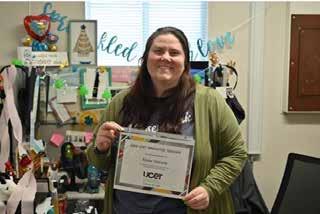
Computer Science department lead Nichole Shelton described Van Ausdal as a visionary educator who is shaping the future of learning.
“Crystal’s passion for AI is contagious,” Shelton said. “She is constantly exploring the newest tools and advancements, always looking for ways they can be meaningfully integrated into education to benefit students and teachers alike. Her dedication to staying ahead of the curve is matched only by her commitment to her students.”
Van Ausdal created a New and Emerging Technologies course to teach students how to use AI safely and ethically.
“The overarching goal of this course is to teach students how to use AI to learn new skills rather than get out of learning.” she said. Students learn to spot bias and dangers and to develop prompt engineering skills. They use these skills to create a Personalized Learning Plan, including generating an AI tutorial to help them study.
“I love this project because it puts students in the driver’s seats and helps them develop a skill that will enable them to become lifelong learners,” Van Ausdal said.
Digital citizenship and ethics are a main priority for all three innovative teachers. They all realize the need to prepare students for a digital world and AI in the workplace.
“It is critical to teach students how to ethically and responsibly use AI in school because they will be expected to use AI in the workforce when they exit high school,” Van Ausdal said. l
HERRIMAN TEAM
The Herriman Journal is a monthly publication distributed directly to residents via the USPS as well as locations throughout Herriman. For information about distribution please email hello@thecityjournals.com or call our offices. Rack locations are also available on our website.
The views and opinions expressed in display advertisements do not necessarily reflect or represent the views and opinions held by Loyal Perch Media or the City Journals. This publication may not be reproduced in whole or in part without the express written consent of the owner. © 2019 Loyal Perch Media, Inc.
Bryan Scott | bryan.s@thecityjournals.com
EDITOR
Travis Barton | travis.b@thecityjournals.com
ADVERTISING EXECUTIVES
Mieka Sawatzki | mieka.s@thecityjournals.com
Lindsay Andreasen | lindsay.a@thecityjournals.com
Jason Corbridge | jason.c@thecityjournals.com
Ryan Casper | ryan.c@thecityjournals.com
Marc Davis | marc.d@thecityjournals.com
Rack
Lydia Rice | lydia.r@thecityjournals.com 385-557-1022
Stacey LaMont
9500 South 500 West, Suite 205 Sandy, UT 84070 PHONE: 801-254-5974

Krista Gibbons receives a 2025 Innovative Teacher Award from the Utah Coalition for Educational Technology. (Photo courtesy Krista Gibbons)
Local nursing programs graduate thousands of Utah residents
Nursing education is anticipated to grow by at least 8% in the next 10 years. Utah’s local nursing programs are ready to help students move into the backbone of the healthcare industry.
By Cassie Goff c.goff@mycityjournals.com
ThroughoutMay, graduating nursing students have been walking across stages at their graduation and pinning ceremonies. Thousands of new nurses will begin and/or continue their careers in health care in summer 2025.
“Nurses make up the largest single group of healthcare professionals in the nation and are increasingly taking on more responsibility in healthcare up to and including taking on the role of primary patient care at doctoral levels,” said Bridgerland Technical College Practical Nursing Director Eric Haskell.
“The growth of nursing programs in Utah has been widely recognized as a proactive and necessary response to the state’s ongoing nursing shortage,” said Communications Director at Mountainland Technical College Maile Richardson. “Institutions across the state, including MTECH, have expanded their programs to meet the increasing demand for qualified nurses.”
In Utah, there are over 27 different nursing programs available through post-secondary education institutions for aspiring students to choose from. Students may apply to different programs depending on their options for their hybrid flexible schedules, smaller class sizes, networking opportunities and variable tuition rates.
For example, MTECH’s nursing program (new location in Provo) focuses on hands-on training with industry experts, lab simulations and clinical sites. While Roseman University of Health Sciences College of Nursing program (South Jordan) offers specialty and leadership roles during twoand four-year programs.
“Many of our LPN (Licensed Practical Nurse) students are returning to school after a significant break, balancing education with parenting, work or caregiving responsibilities. This life experience gives them maturity, resilience and a strong sense of purpose,” Richardson said. “Students learn relevant and industry-standard best practices from current nurses.”
Some of these local nursing programs even partner with one another. For example, the two technical colleges mentioned above partner with local universities to help nursing students continue through their education and career goals.
Bridgerland Technical College partners with Weber State University to guarantee BTECH’s graduates a spot in Weber State’s

“Bridgerland Technical College graduates are highly coveted in our local market. Most end up working at one of two local hospitals, local skilled nursing facilities or clinics and a few seek and gain employment at large trauma centers such as Primary Children’s or St. Marks,” said Practical Nursing Director Eric Haskell. (Eric Haskell/Bridgerland Technical College)
Registered Nurse program.
“We share space in our building with Weber State so (students) would attend all of those classes here at BTECH,” Haskell said.
A similar partnership agreement exists between MTECH and Utah Valley University, as students can move directly into UVU’s RN (Registered Nurse) program.
“All of our most recent LPN graduates plan to go to UVU in the fall,” Richardson said. “Students are excited about this transfer credit opportunity and have found it very valuable.”
The majority of students attending the nursing programs listed above are Utah residents. BTECH currently has 96 nursing students per year primarily local to northern Utah, most from Box Elder and Cache County. While MTECH does draw some nursing students from out of state. Last year, 2,093 students graduated from Western Governors University’s nursing programs during their 100th commencement class.
“The goal of nursing…is a science and an art. The science is obtaining research-based nursing knowledge, judgement and skills. The art is the establishment of a caring relationship through which nurses apply nursing knowledge, skills and judgement in a compassionate manner,” said Roseman University’s Director of Marketing Rachel Thomas.
For readers who may be considering nursing school in the future, a few recommendations were offered. Richardson recommended taking the prerequisites of anatomy and physiology beforehand. Haskell echoed that sentiment with the addition of medical terminology and psychology cours-
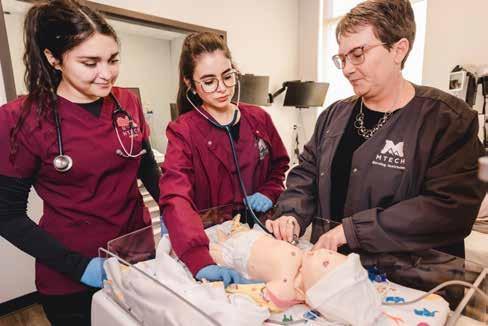
“Once students are in the program, students can expect hands-on, engaged learning. During their time in the program, students will experience classroom-style lessons, hands-on lab simulations, and have opportunities to work in clinical sites.” (Maile Richardson/Mountainland Technical College)

Bridgerland Technical College has been recognized regionally and nationally for their outcomes, affordability and resources. (Eric Haskell/Bridgerland Technical College)
es too. Some of the local nursing programs look for students to have already obtained their Certified Nursing Assistant (CNA) license.
“When nursing school starts, you’ll have plenty of work and studying that you'll need to do,” wrote nursing student Molly Jae Cox through the Nursing Programs Facebook group. “You need a stethoscope and a pen light, and they’ll give you scrub specifications as well.”
Beyond the nursing programs listed above, Utah offers nursing programs through (listed from least-expensive to most-expensive on average tuition costs): Davis Applied Technology College, Night-
ingale College, Uintah Basin Applied Technology College, Utah Tech University, Galen College of Nursing (Draper), Salt Lake Community College, Snow College, Utah State University, Brigham Young University, Southern Utah University, Joyce University of Nursing & Health Sciences and Westminster College.
“Nursing education programs generate more than $8.5 billion in annual revenue, representing nearly 3% of all higher education revenue,” said Alyssa Reynolds, public relations associate for Validated Insights Market Research. “By 2030, the nursing education market is projected to be worth $14.6 billion.” l
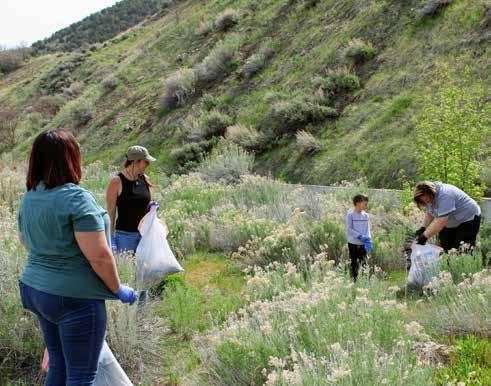
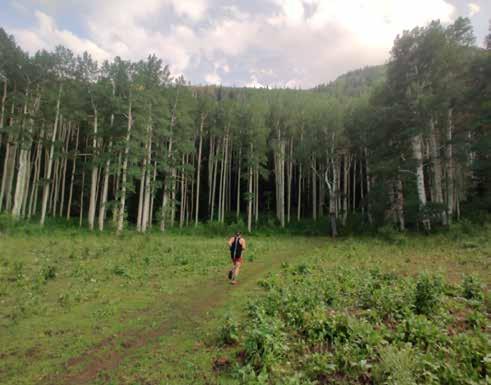
Understanding and protecting the Oquirrh Mountains
The overlooked peaks on the valley’s west side are being affected by growth.
By Peri Kinder peri.k@thecityjournals.com
Framing
the Salt Lake Valley’s west side, the Oquirrh Mountains often take a back seat to the more famous Wasatch peaks on the east. Steeped in a rich history of industry, most people associate the 30-mile-long mountain range with the Bingham Canyon Mine, the deepest open-pit mine on the planet.
As development approaches the Oquirrhs (a Goshute word meaning “wooded mountain,”) more people are discovering the recreation opportunities in those canyons, which some say creates an urgent need to address growth and preservation. A group of University of Utah researchers studied the history, environmental challenges and future of the Oquirrh Mountains, and presented their findings on Earth Day.
Cait Quirk moved to Utah from the Pacific Northwest, where she worked as a mountaineering instructor. While studying at the U, she was excited to explore the Wasatch range but wanted to learn more about the mountains to the west. She was surprised by how little the Oquirrhs were understood by the valley’s residents.
“I talked to people who had lived in the Salt Lake Valley for 20 years and didn’t even know the name of the Oquirrhs,” Quirk said.
“How can that be? As soon as I moved here, I wanted to run and explore and ski in them.”
She approached Dr. Jessica DiCarlo, a human geographer and political ecologist at the university, to see if she could spend a semester studying the Oquirrhs and why the range doesn’t receive the same interest as the Wasatch.
Mara Scallon and Maddie Hill joined the project that attempted to answer the questions: why do the Oquirrhs seem inaccessible, how can we understand the land and what role does industry and history play in the public’s perception of the mountains?
When researchers asked the public to define the Oquirrh Mountains, they used words like “underrated,” “exploited,” “stepchild,” “surprising,” “beautiful” and “Oquirrific.”
“We realized there was a disjointed perspective between how people thought about and perceived the Wasatch. They’d go out there every day for runs, but they had never once been out to the Oquirrhs to experience that,” Scallon said. “We were curious about how that shaped different perceptions, this whole idea of things hiding in plain sight. There was a mountain range, but people didn’t know the name of that range. That was interesting.”
They talked to residents, federal employees, state and county officials, historians and nonprofit groups like The Oquirrh Foundation. They hiked and ran on the trails, did some backcountry skiing and participated in several events held on the mountain.
By studying archival photos and local histories, the researchers found virtually no
information about Indigenous tribes who had lived there, and no information about women who had helped settle the area. However, there was vast information about the mining industry in the Oquirrh Mountains.
Scallon said they discovered there are nearly 300 archaeological resources in the range, but because most of those sites are on private property, no guidelines have been set for preservation.
“It goes to show that visibility in history depends on land ownership and depends on industry,” she said. “That led us to ask, if there are hundreds [of archaeological resources] that the state knows about, what else is there that is not known?”
The Oquirrhs are a mash-up of private ownership, federal and public lands, and military properties, with Camp Williams and the Tooele Army Depot located on its east and west sides. Property owners don’t seem to welcome the public accessing the area, as demonstrated by the numerous “No Trespassing” signs.
In 2023, Salt Lake County opened Herriman’s Butterfield Trailhead Regional Park. It includes 13 miles of trails for hikers, mountain bikers, equestrians and runners. As a competitive mountain biker, off-road trails are one thing that enticed Hill to move to Utah from California. She said the Oquirrhs offer a dynamic recreational landscape that seems to be underutilized.
“These trails have become more than just an outdoor outlet. They are something that promotes health, environmental stewardship and community pride,” Hill said. “I also view
these trail systems as a place for growth, connection and mentorship. These trail systems serve as a way to keep [people] engaged in the outdoors for many years…People of any age or any demographic can come together and embrace the beauty of these mountains.”
As sprawl inches toward the Oquirrhs, Quirk expressed the necessity for stewardship and environmental protection. She noted the EPA has still not designated the Kennecott Superfund sites in Magna and Copperton as safe for soil or water. Quirk applauded the Oquirrh Foundation’s efforts to preserve lands and facilitate community engagement through events and clean-up activities.
“Most people we talked to really want to develop safe and healthy places for generations to come,” she said. “Conservation goals will take a lot of different stances, but people noted that some habitats should not have more human impacts. To limit disputes, there needs to be preservation that spans different mindsets.”
Scallon said the big question for the Oquirrhs is, how will human and environmental health be prioritized over profit? As more communities are built near the range, what is the impact on water resources and air pollution? How does the increase in wildfires and the possibility of toxic chemical exposure change the way cities expand in that area?
“Whose voices are being left out of these conversations about development and about the growth that’s happening in the region?” Scallon asked. “As humans change how the land is being used and accessed, that can cause some significant challenges.” l
Recreational opportunities in the Oquirrhs are becoming more popular as residents discover this range that tends to be overshadowed by the Wasatch Mountains. (Photo courtesy Bennion Gardner)
The Oquirrh Foundation organizes clean-up events to keep the Oquirrh Mountains healthy and to bring attention to the range on the west side of the Salt Lake Valley. (Photo courtesy Bennion Gardner)
Drumroll please…MRHS percussion team hits semifinal level at world championships
Talented staff, dedicated students and parental support were key players in drumming up success for the MRHS indoor percussion team.
By Jet Burnham j.burnham@mycityjournals.com
This April, Mountain Ridge High School’s Indoor Percussion team was the first Utah high school team in more than 20 years to compete in the Winter Guard International World Championships in Dayton, Ohio. They were shocked when they then qualified for the semifinal round and finished in the top half of the 50 groups in their division.
“I went with the attitude that, ‘Oh, it’s our first year, maybe we’ll learn a lot from the world class groups or the other groups,’ but I was very surprised to see that we could stack up to the others,” senior Brian Stooksbury said. “Just from the very start, we set up ourselves for success by great teaching and practicing hard and we made it a goal every season to build on top of what we accomplished the past season, whether getting new awards or playing harder music, but we just felt like we’ve been progressing every season at a linear rate, just trying to get better every season and build on top of the success of last season.”
Percussion Director Cris Stiles knew the team had potential when he came to MRHS four years ago, rebooted the program and hired professional show designers.
“The staff and I realized, with this design team and these kids, we really have something kind of special,” Stiles said. “We started going back to the basics and watching how eager and how excited the kids were to take on some of those things— they were very, very teachable, and ran with what we taught them. So it became pretty clear to us very fast that we wanted to do something exciting.”
The dates of Winter Guard International World Championships fit their schedule so they began to prepare for the elite competition.
Delena Haywood has watched the indoor percussion program grow through two of her sons’ participation.
“The second Cris came into it, he made this band program something it’s never been before,” Haywood said. “The interaction he has with these kids and the way he teaches them, it’s his personality that he brought that has made the entire difference. He pushes these kids to do something better than they’ve done, or that they’re better than they think they are.”
Katie Vawdrey, who was part of the
Every single one of those kids were on cloud nine like I had never seen them before. They played their hearts out in semis, and they knew it, and they could feel it, and they were just elated.
— Delena Haywood
visual ensemble, said, “You can only do so much as a student without good staff, so our staff really makes the difference in us having the success that we’ve had.”
The students said performing at an international championship in the biggest venue they’d ever performed in, and learning from talented and experienced teams, was an amazing experience.
“In the staging behind the curtain, we were just getting ready and trying to get in the mindset,” Stooksbury said. “The energy was really high because we were in such a big arena. Everybody was like fist pumping and congratulating each other—just the energy was really high and the vibes were good.”
When they found out they made the semifinal round, the students’ confidence crescendoed and they focused their energy on additional rehearsals.
“Those were the most productive rehearsals I’ve ever had,” junior Madi Condie said. “We were just really giving the performance energy and we were really working towards the thing, because we had seen these other groups, and we were inspired, and we were working towards semifinals.”
“Going on to semifinal, it was fresh, we’d done the work, sort of re-confirmed ourselves, and the kids had their absolute best show they’ve had all season,” Stiles said. “It was totally inspiring.”
The scene immediately after their semifinals performance was electric and emotional.
“Every single one of those kids were on cloud nine like I had never seen them before,” Haywood said. “They played their hearts out in semis, and they knew it, and they could feel it, and they were just elated. They were screaming and just hugging and high-fiving, and couldn’t believe that they just played in semis at World’s.”
The team will be competing in a new division next year, where they will take on harder music and face tougher competition.

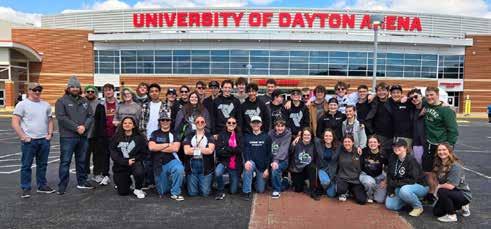
“We want to keep growing as an ensemble, making sure that we keep building on top of what we’ve been learning as a program, and try not to take any steps back and just to move,” sophomore Lillian Loertscher said.
Stiles said the financial and logistical support of the parents has been pivotal to the team’s success. Not only do parents cheer from the stands, but parent volunteers help move equipment on and off the performance area, create merchandise, organize fundraisers, manage uniforms and arrange meals.
“We definitely rely on the parents to help volunteer and come support,” parent volunteer Cindy DeNamur said. “It’s not always fun just sitting around in the park-
ing lot, waiting for the next performance and pushing things along, but everybody always signs up.”
For the world championships, a parent drove to South Dakota to pick up the props for the show. Others accompanied the team to Ohio to support them through long days of rehearsals and competition. One couple flew out last minute for the semifinal round when they heard the team had advanced.
“I’m not sure how it would be pulled off if you didn’t have the parent volunteers,” Haywood said. She and her husband Ronnie took on the responsibility of feeding the team at competitions and of towing the band’s equipment trailer to Ohio. l
Mountain Ridge High School’s Indoor Percussion team’s show—designed by Noe Gomez, Peter Bates, Trent Gronewold and Jared Andrews—features an erupting volcano. (Photo courtesy Cindy DeNamur)
Mountain Ridge High School Indoor Percussion team was the first Utah high school team to compete in the Winter Guard International World Championships in Dayton, Ohio for more than 20 years. (Photo courtesy Cindy DeNamur)
By Jet Burnham j.burnham@mycityjournals.com
Herrimanarea schools have an abundance of extraordinary educators. Here are some who have received special recognition this year.
Bastian Elementary School counselor Alisha Martinez, 2025 JSD Jordy Award for Outstanding School Counselors
Copper Mountain Middle School health teacher Samantha Jenkins, SHAPE’s Health Education Teacher of the Year
Copper Mountain Middle School band teacher Keith Davis, Outstanding Junior High/ Middle School Music Educator of the Year
Copper Mountain Middle School math teacher Jess Bryant, Mountain Valley Chamber of Commerce Teacher of the Year
Herriman High School business and marketing teacher Randy Kammerman, 2024-25 Utah Jazz Most Valuable Educator and Utah DECA’s Jim Powell Adviser of the Year
Herriman High School ASL teacher Tawny Bowman, Mountain West Chamber of Commerce Teacher of the Year
Itineris Early College High School, Robert Machol, Innovative Teacher Award from the
2025 Outstanding Educators
Utah Coalition for Educational Technology
Kelsey Peak Virtual Middle School social studies teacher Krista Gibbons, Innovative Teacher Award from the Utah Coalition for Educational Technology
Mountain Heights Academy, Crystal Van Ausdal, Innovative Teacher Award from the Utah Coalition for Educational Technology
Mountain Ridge High School choir director
Kelly DeHaan, Jordan School District 2025 Teacher of the Year
Mountain Ridge High FACS teacher Corie Johnson, Family and Consumer Science New Teacher of the Year
Silvercrest Elementary, Carol Ramsay, Mountain West Chamber of Commerce Teacher of the Year
South Valley School, Chelsea Lopez, 2025
Utah Council for Exceptional Children Outstanding Paraeducator Award
Spectrum Academy, Andrew Delcamp, UCET Innovative Teacher of the Year
Jordan Education Foundation chose one Outstanding Educator of the Year from each of the 68 schools in Jordan District. Herriman area school winners are listed below. (* indicates top winners)
Bastian Elementary School, Kristen Wahlin
Blackridge Elementary School, Diana Rose Copper Mountain Middle School, Christopher Bergum
Fort Herriman Middle School, Kimberly Mendenhall
Herriman Elementary School, Jennifer Jameson
Jordan Academy for Technology & Careers, Lisa Wadzeck
Juniper Elementary School, Mackenzie Brown
Kelsey Peak Virtual Middle School, Kymberly “Kym” Harrison
Kings Peak Virtual High School, Sharman Holloway
Ridge View Elementary School, Emanuel “Manny” Colon*
Rocky Peak Virtual Elementary School, Emily Baugh
Silver Crest Elementary School, Launi Drecksel*
South Valley School, Emily LaRue*
Launi Drecksel, Silver Crest Elementary School “Launi is a master teacher! I am blown away by her ability to connect with and reach each learner. Every student feels seen and cared about. She gives clear instruction and expectations, and students rise to the challenges given. Her classroom is a safe and nurturing space where students feel valued and motivated.”- a colleague Emanuel “Manny” Colon, Ridge View Elementary School “It is rare to walk by his office without seeing Mr. Colon using fun and play to teach and practice social skills, emotional regulation and self- control to a group of students. Around the school Manny is affectionately known as “Mr. Dinosaur.” -
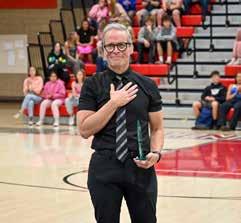
assistant principal Beth Pollock
Kelly DeHaan, Jordan School District 2025 Teacher of the Year “Kelly DeHaan has a brilliant mind and focuses on each of his students. He loves his job and the music he puts in front of the students. He works with each individual and cares so dearly about what’s happening in our personal and academic lives. DeHaan really makes each of his students special in different ways. He notices little things as well as big things. He is a very dedicated man and I adore that about him. He really does love each of his students and their efforts.”- a student l




Mountain Ridge High School choir director Kelly DeHaan is named Jordan School District’s 2025 Teacher of the Year. (Photo courtesy JSD)
Herriman and Bluffdale: A tale of two of the fastest-growing cities in the U.S.
Salt Lake County’s southwest region is experiencing fast-growing development.
By Peri Kinder peri.k@thecityjournals.com
With
129% population growth since 2014, Herriman is experiencing a rapid expansion that creates multiple challenges and many opportunities. Coming in at 15th, Herriman was one of seven Utah cities listed as the 100 fastest-growing in the country, in a report released by StorageCafe.
Following close behind, Bluffdale ranked 21st, based on its population increase in the last decade. Eagle Mountain (22), Saratoga Springs (23), West Haven (39), Santaquin (81) and Lehi (89) also cracked the top 100.
Herriman Community Development Director Blake Thomas said much of the city’s growth is attributed to the availability of open land, which is cheaper to develop than infill areas, but the transition from agriculture to commercial and residential development has impacted the community’s culture and infrastructure.
“Moving more from a rural, agricultural-based community to a suburban community brings in a lot more demand for commercial development services to support the residents here,” Thomas said. “So we went from a lot of single-family homes to more town homes and multi-family housing. That’s a big shift that impacts traffic and other things.”
Herriman is also seeing hospitality expansion, with its first hotel currently under construction. It’s brought in restaurants and retail options, and plans to create a sports entertainment complex that will create jobs and recreation opportunities
for residents.
The 2022 Herriman Wellbeing Survey showed a majority of residents surveyed felt growth was happening too fast in the city, raising concerns about the water supply, transportation issues, affordable housing and air quality.
“We’re trying to bring in services that will alleviate some of the issues we’ve seen,” Thomas said. “We’ve worked with UTA to address routes to help with transit and, hopefully, we can end up with dedicated routes that help people get in and out of the city.”
Several roads in Herriman are being constructed or widened, the Commons at Herriman Towne Center will be a key commercial area, multi-use trail expansion is happening in the Oquirrhs and there are plans to build a tunnel under the freeway to connect to the Bonneville Shoreline Trail.
Bluffdale, Herriman’s neighbor to the east, doesn’t have as much open land available and its rapid growth has necessitated extensive infrastructure planning, including roads, parks and schools.
“It’s been really beneficial because we have all those new families, young families have moved here,” said Bluffdale Community & Economic Development Director Grant Cowell. “It’s been great and it’s introduced some new development types.”
The population increase in Bluffdale has attracted several commercial developments, including restaurants, convenience shops and the city’s first grocery store. Smith’s Food & Drug is building a location at 13893 S. Redwood Road that’s expected to open in September.
Future development in Bluffdale includes major transportation infrastructure and new zoning requests on the south end of town. That will be the last available land until the Point of

the Mountain gravel pit stops production, opening up several hundred acres of land in the city. It will also be impacted by The Point development in Draper and the adjacent FrontRunner station in Bluffdale.
“That’s pretty exciting because I think we’re just kind of at the beginning of that growth curve,” Cowell said. “People love being here. People on the west side of town love that historic feel and the larger lots. The newer residents love how some of these projects have integrated open space and parks. So I just see how much people love it here. I’m glad to be part of it.”
StorageCafe, an online self-storage marketplace, analyzed more than 2,500 U.S. cities with at least 10,000 residents, ranking them by percentage population change from 2014 to 2023. The full report is available at storagecafe.com/blog. l
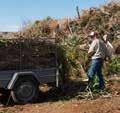

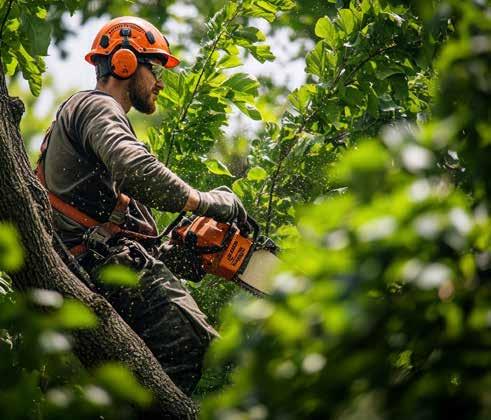
Herriman City is ranked the fastest-growing city in Utah, by StorageCafe. Its exponential expansion is due to its appeal to families, young professionals and outdoor enthusiasts. (Adobe stock)































City council approves land trade deal for sports complex
Hoping to break ground on a sports complex in the not-too-distant future, Herriman will trade three properties to developers for one larger parcel.
By Elisa Eames e.eames@mycityjournals.com
Inits quest to increase city funding without increasing the burden on residents, Herriman City has approved a land trade deal with developers, bringing it one large step closer to building an athletic complex.
“The city owns several parcels, but they’re very disparate, and some have impacted soils from Rio Tinto operations in the past,” former Councilman Steven Shields said.
Herriman has worked with developers to orchestrate the swap without involving cash. Per city protocol, the planning commission reviewed the proposals and made a few suggested changes at the April 2 planning commission meeting.
At this meeting, the planning department advised the planning commission that city services would be sufficient to support the increased population and that proposals are in line with “the character of surrounding neighborhoods.” A discussion of the land swap in more detail was then put on the agenda for the April 23 city council meeting, when council members voted to approve the trade of three separate parcels for one larger contiguous property, which would host the complex.
“The city didn’t own the land where the athletic complex is proposed—it was privately owned and planned for housing,” the city’s website says. “To make the complex possible, the city traded some of its land with the developer. In return, the city received the land for the proposed complex, and the developer was allowed to build homes on the city’s land instead.”
The land deal, which is expected to be completed in June, will also clear the contaminated soil.
Still only a concept, the sports complex
would provide space for local recreation and regional and national competitions. It would also aim to attract patrons from outside of Herriman to spend money at stores and restaurants within Herriman, allowing the city to collect sales tax on transactions without having to provide city services to visitors. The city would also expect the complex to attract new businesses while increasing sales for existing ones.
“The purpose of pursuing the project is to support local and regional recreational needs, stimulate business activity and help reduce long-term pressure on property taxes through increased sales and tourism tax revenue,” Herriman’s website says.
“Is this the magic bullet that solves all of the city’s economic problems? No, but it is a good step in the right direction,” Shields said.
The city also plans hotels to accommodate overnight visitors, further increasing revenue. Construction began in April for a Holiday Inn Express near Premier Pickleball and Slackwater Pizza within the Anthem commercial development. The hotel is expected to be completed sometime next year.
Hyatt also plans to build a longer-stay facility in the Academy Village commercial development, though dates have not yet been determined.
Two of the properties to be traded are the 29-acre “Creek Ridge Cove” property on the corner of 6400 West and Herriman Blvd., which includes 136 single-family homes, and the 2.54-acre “Big Bend Cove” property, which includes 11 single-family homes. Formerly, “Creek Ridge Cove” was envisioned as a park or sports area, and “Big Bend Cove” was considered for the site of a fire station.
The third parcel, the 18-acre “Sorrento” property, previously called “Walker Cove,” is on the corner of 12900 South and Rosecrest Road (5600 West) and was originally planned as a public works facility.
In January, the city council considered a proposal for 212 units for the “Sorrento” parcel, including detached homes and townhomes, but after receiving significant community feedback, council members amended the number of residences to no more than 113
detached homes. Independent of the complex, the location of a new fire station will be on the southwestern side of the “Sorrento” property.
Unit increases for the Teton Ranch and Olympia developments will also be part of the swap, and the “Sorrento” parcel will be rezoned.
The master development agreements for each parcel stipulate that the street arrangements must provide adequate traffic circulation through the developments, and developers must meet city architectural standards. This will undergo further scrutiny when construction begins.
Many public comments over the last few months have included concerns about density, preserving “Old Herriman,” traffic, overcrowded schools and parking.
“You look to the [east, north and] south. It’s not that dense, and all of a sudden, we’ve got this density in the middle of… Oldtown Herriman,” resident Chance Gledhill said.
However, the Utah state legislature has recently pushed for smaller lot sizes in new construction to make homes more affordable. “I think the average cost of a single-family home in Herriman is around $650,000, so anything we can do to bring that down to help people buy homes, we’ll try to accomplish that,” Herriman Director of Community Development Blake Thomas said.
Another resident, Justin Butterfield, lamented the impact on traffic. “It takes you 20 minutes to get to Bangerter right now, and it’s not just because of the construction on 134th… And now you’re going to have this many more people there in that tiny little area,” he said.
“The city regularly monitors traffic levels on major roads and plans improvements as needed. These projects are already included in long-term plans,” Herriman’s website says.
Additionally, Jordan School District has confirmed that the number of children per household is decreasing, and the city has been advised that current schools can handle the increase.
The “Sorrento” development, for example, is expected to provide 41 elementary school students within the boundaries of
Herriman Elementary, where the current enrollment is 674 with a projected enrollment of 635 for next year. Including portables, Herriman Elementary can accommodate 750 students.
Another contentious subject, parking has been carefully considered in the planning process thus far. “If the project moves forward, the city will study parking needs and use best practices from similar complexes to provide adequate capacity and minimize overflow,” the city’s website says.
Other public concerns have included access, animal rights, erosion of public trust, infrastructure strain and safety issues. Creek Ridge area residents also expressed frustration over a planned park that will now be homes instead. The city intends to take this into account during the design process for the complex to provide green space for the area.
“All this feedback from the residents has been a part of deliberations. It’s impacted negotiations. It has changed plans… It has frankly given us leverage in negotiations with developers to bring about better results,” Shields said. “The hard part… is that you don’t always get the decision that is best for you individually but may be better for the city overall.”
Because it lacks the resources to build the complex, the city has conferred with Salt Lake County and other organizations about funding and other issues.
“We can’t guarantee other people’s resources to make this happen, but there’s been a lot of interest…” Shields said. “We want to make it very clear again that the athletic complex is not approved. It’s not finalized. It’s not even designed yet, but that’s the goal for this.”
Residents can offer more feedback throughout the upcoming process via public meetings and discussions, and the city encourages involvement and staying educated. For more information, see the “Proposed Southwest Athletic Complex” page on the city’s website, Herriman.gov and the April 2 Herriman City Planning Commission Meeting on YouTube.com. l
A draft shows tentative plans for an athletic complex. (Photo courtesy Herriman City)
Developers plan 136 single-family homes for the “Creek Ridge Cove” property. (Photo courtesy Herriman City)
Previously slated for a fire station, the “Big Bend Cove” property will be the site of 11 homes. (Photo courtesy Herriman City)
Community Heroes: High school choir director left lasting impression on thousands of students
Kerry Moore cared about his students beyond the classroom.
By Becky Ginos b.ginos@mycityjournals.com
Mostkids don’t remember their high school teachers let alone keep in touch for years after graduation but it’s different with Kerry Moore’s students. The Bountiful man was the choral music director and German teacher at Cyprus High School for 35 years and left such a lasting impact that former students still called him “friend.” Moore passed away April 16 after a lengthy battle with pancreatic cancer.
“He was an amazing teacher and so much more,” said Brent Graham, who graduated in 1998. “He was the person I needed at the time. He was the closest thing to a father.”
Graham grew up without a father and his mother passed away after he graduated. “It left a big hole,” he said. “I was a scared little 19 year old. They (Moore and his wife Stacey) basically took me in. They’d invite me to Sunday dinner and Christmas. Otherwise I would have been alone.”
He loved teaching, said Graham. “It wasn’t a job, it was like a calling. He made you want to be a better person. His joy was infectious.”
“He was that guy,” said Blake Halladay who graduated in 1997. “You knew he cared beyond class. Many times I’d talk to him after school for hours. If kids had personal problems at home he’d step in to help. He was there for that.”
Kerry and Stacey were a power couple, Halladay said. “They could have done so much but they chose to teach high
school. That says volumes about their character.”
Once kids graduated it didn’t end, he said. “My wife and I would go places with them. There are three men who changed the trajectory of my life. My father, my father-in-law and Kerry.”
Halladay spent time with Moore a few days before his passing. “I told him ‘I’m a better man because of you.’ He said, ‘Me too.’ That really hit me to think he feels blessed by me.”
“The most interesting thing about him was the passion and love he’d put into every project,” said Liz Oates who graduated in 1997. “You never felt like an afterthought. He wanted us to succeed. He would push us but we always felt that love.”
Oates said Moore was close friends with her father. “He and my dad were such good comrades. My dad wrote some music and when he died unexpectedly from a heart attack Kerry played dad’s album at his funeral. It was so touching. He was busy in his life but it was so special that he took the time to do that.”
Her senior year, Oates said one of her classmates was homeless for a time and living in her car. “He would check in on her and another classmate who had a horrible thing happen to her. He sat down and consoled her. That’s why so many people remember him. If you were down and out he’d be a friend to help people to recover.”
“Kerry was so patient and loving,” said Jeremy Felt who graduated in 2019. “He helped us find success. He would check our grades and see what he could do to help.”
In addition to choir, Moore was involved with the school musicals, Felt said. “I did a lot of musicals with Kerry and his wife who did the choreography. When I was the lead in ‘Pirates of Penzance’ he told me to envision the music. He said music is the universal language to connect with people. He said the words

might fade but they would always remember that song—music is so impactful.”
Felt said he also took music theory from Moore. “I still have my binder that he created. I create music for fun now in remembrance of Mr. Moore. I’m involved with community choirs and theater because of Mr. Moore.”
He was like Mr. Rogers, said Felt. “I’m so grateful that I got to be a part of his life. He touched the lives of others. He’s going to be missed.” To submit your Community Hero, email hero@ thecityjournals.com l

Herriman High finishes as state runners-up in unified basketball
By Julie Slama j..slama@mcityjournals.com
In a state final against Woods Cross High, Herriman High’s co-ed unified basketball team came up short in their division in a hard-fought game.
The Mustangs had secured the opportunity to play in the March 28 championship at the Delta Center after advancing from the regional Canyons-Jordan-Murray school districts’ tournament.
Unified basketball embraces students with and without intellectual disabilities to play side by side. The program, supported by both Special Olympics Utah and the Utah High School Activities Association, now boasts more than 200 high school co-ed unified basketball teams across the state.

Kerry Moore (left) with former student Brent Graham. The pair continued to be close friends for years after Graham’s graduation. (Photo courtesy of Brent Graham)
No student should go hungry: One parent’s mission to end statewide school lunch debt complements new
Starting July 1, about 40,000 students in Utah will receive free school meals, thanks to House Bill 100, the Food Security Amendments. This legislation eliminates reduced-price lunches, making them fully free for students who previously qualified for the reduced rate.
Sponsored by state Rep. Tyler Clancy, the new legislation aims to address food insecurity and promote share tables to reduce food waste. It guarantees free school lunches for eligible students — from kindergarten through 12th grade — at any school participating in the National School Lunch Program.
Darrell “DJ” Bracken, a West Jordan parent and community advocate, believes the new law also will help tackle Utah’s growing school lunch debt, which reached $2.8 million last year.
“I was just down at the capitol yesterday when Gov. (Spencer) Cox signed the bill,” he said. “I was a part of the coalition along with The Policy Project and Utahns Against Hunger; we advocated for it for about eight months. I think it was very hard for legislators to directly reject the idea of feeding kids at school. I think it’s something everybody can get behind.”
Bracken was shocked when he first learned the extent of lunch debt in his local school district.
“I thought that was impossible. I called Jordan School District and they confirmed to me not only is that number true, but there’s $88,000 in debt in elementary schools alone within my district. I was just completely blown away,” he said.
Motivated to act, Bracken began by paying off Bluffdale Elementary’s $835 lunch debt himself. That experience led him to start the Utah Lunch Debt Relief Foundation to ensure no child in Utah schools goes hungry or accumulates meal debt.
“I thought other people would be just as upset as I am that this exists — and I was right,” Bracken said.
His foundation is designed as a temporary solution to a systemic problem.
“I didn’t want to fill a role I personally felt the government should already be filling so it’s in our charter we will exist until we have gone one full calendar year without any school lunch debt in the state of Utah. This bill is a great solution. It does many great things, taking the group of kids who are getting reduced lunch into getting free lunch. But there’s still going to be lunch debt. I view this as kind of a steppingstone toward healthy school meals for all; that has been passed in a lot of other states. I would like to see that passed in Utah,” he said.
Bracken’s efforts gained momentum after a single Facebook post in July 2024.
“That got a lot more response than I expected, and we’ve been paying off schools
ever since,” he said.
By mid-April, UTLDR had raised more than $51,000. The foundation has cleared meal debt at several schools: Bluffdale, Oakcrest and Aspen elementaries in Jordan School District; South Kearns Elementary in Granite School District; Liberty Elementary in Murray School District; Butler, Quail Hollow and Sandy elementaries in Canyons School District; and more schools in Davis, Provo, Carbon and Duchesne school districts.
Bracken’s goal is to pay off meal debt at an elementary school in every district statewide.
“We’re well on our way to doing that,” he said. “It’s mostly individual people finding our website and deciding to donate on their own, but we have had a couple partnerships with businesses. It’s really been an amazing thing to see how many people care about this.”
Some donations come from individuals moved by the cause. One is 17-year-old David “Van” Hafner, who contributed $2,500 toward paying Butler Elementary’s $6,050 lunch debt. Lunches in Canyons School District cost $3.
“I had my own college saving fund and I dipped into that, plus savings from my many summer jobs and money I saved from the stock market,” he said. “I had a lot of money saved up different ways, so I pulled it all together. I like the idea of doing philanthropy, and I thought this was perfect.”
The Alta High junior also volunteers at a West Valley City daycare and plans to join a humanitarian trip this summer. He was honored with the Smith’s Zero Hunger Award and intends to continue helping schools.
“It’s important I’m doing this because kids at a young age need to learn to help the community, to help other people. I wanted to make an example of that by giving my money to kids who can’t pay for their own lunch. The main concern is kids eat, especially a growing little kid,” said the student who hopes to become a doctor.
His generosity left a lasting impression at the Cottonwood Heights elementary.
“The people at the front desk were very thankful and the kids were excited. They said, ‘That’s a lot of money,’ and ‘That’s really cool.’ It made me feel great. That’s why I want to donate to another elementary school,” Hafner said. “Between this and the West Valley City daycare, it feels like I’m making a difference.”
Butler Principal Tracy Stacy said she was both surprised and grateful for the donation.
Another community member contributed; she encouraged her gym members to get involved and raised money to help pay off Sandy Elementary’s lunch debt, Bracken said.
state law

At Aspen Elementary in South Jordan, Bracken’s foundation donated $2,100. However, debt stemming from $2 per lunch continues to be a recurring issue, said Principal Suzie Williams.
“We’re grateful for the donation, absolutely, and we’ve used it, but we don’t want it to be a crutch for people either,” Williams said. “We want to help them navigate how to pay or qualify for lunches. When he came, he tried to reach out to a bunch of families and educate them about filling out forms for free and reduced lunch and that helps, too.”
She noted despite the efforts, debt remains a challenge.
“His donation helped, but we got back up to $3,000 deficit (in late March). When you hit $50 in Jordan School District, then it goes to collections. We called several people today and told them that — and it’s awful. Our lunch debt is down now at $1,700 (as of late April); there always is a debt,” Williams said.
At Liberty Elementary where school lunch is $1.90, Principal Shana Mondragon echoed similar concerns.
“We are consistently in the negative. We’re constantly reaching out to families asking, ‘Do you need help? Have you applied for free and reduced lunch? Do you qualify?’” she said. “I think families are struggling. The responses I get when I call range everywhere from ‘I totally forgot to pay’ to they don’t know how to fill out the form, or didn’t know there was a form. There’s also everybody ate lunch for free during COVID so the assumption is it’s still going. I do appreciate in Murray, regardless of what their balance is, students have the option to get a full lunch every day. It doesn’t fix the budget side of it, but the kids will always get a full meal. Murray District’s top concern is that the kids eat. We’ll figure everything else out later, but we
need to make sure the kids have food. “ Mondragon praised Bracken’s dedication to helping families and spreading awareness.
“DJ was helping to educate the families, making sure they had access to the information. He really wants to fix the problem. It isn’t a new problem. If anything, it just keeps getting worse. So, making sure there’s funds, making sure there’s accessibility to the resources and knowing what to do is important,” she said, adding Bracken was honored for his $560 donation to pay off the lunch debt as well as his contribution toward fixing the issue during a “hidden hero” school assembly. “The banner for his foundation is on our website and on our fence to recognize what he did.”
Bracken said the foundation continues to expand its outreach.
“There are many great causes in the world. I have a 7-year-old daughter so this was easy for me to picture a world where there’s some kid out there who’s worried about getting school lunch, and how are you supposed to learn if you’re worried about being in debt instead of focusing on things like fractions?” Bracken said. “It struck me as a failure of the system. These are kids who are accruing debt for the right to eat at a place they have to be —– and we all want them to learn. We all want them to succeed. I was just completely aghast this could even exist, and it turns out most people are too. I couldn’t stand for it. Someone had to do something; I’m glad it’s made an impact so far. Hopefully we can make the full impact and make it so no kid ever has to worry about where they’re getting their lunch again.”
To support or learn more about the Utah Lunch Debt Relief Foundation, visit utldr. org. l
Alta High junior David “Van” Hafner, seen here with Butler Elementary students, contributed $2,500 toward paying the school’s $6,050 lunch debt. (Photo courtesy of DJ Bracken)
Newsome brothers enjoy time together for Mountain Ridge boys tennis team
The Mountain Ridge boys tennis team enjoys good team unity and a strong bond. There’s a true family-like atmosphere, especially with brothers Matthias and Bridger Newsome.
By Josh McFadden
Anycoach will tell you that having a close-knit group of players is crucial for a team’s success. Luckily for Mountain Ridge boys tennis coach Parker Hansen, he had good camaraderie on the squad.
And it helped that a pair of brothers were there to pace the Sentinels.
Senior Bridger Newsome and his brother, sophomore Matthias Newsome, were two of the standout performers this season for Mountain Ridge. Both players have worked hard to improve their game and have the attitude and mindset that Hansen looks for. The brothers’ father got the Newsome siblings interested in tennis. Bridger began playing as a freshman, while Matthias is in his third year playing the sport.
Bridger said he gets a lot out of working hard and seeing the fruits of his labors on the court.
“I love to give my all at something, and my competitive nature keeps me coming
back,” he said.
For Matthias, who is part of the Sentinels’ second doubles team, winning motivates him and is what he loves most about playing tennis. He also said he is working hard to improve his serves. Both brothers have enjoyed being a part of the Mountain Ridge program. Not only do they love playing together and working toward the same goals, but they had nothing but positive things to say about their teammates and the coaching staff. Matthias has fun playing with the others on the team, both at matches and at practice. Bridger said team activities strengthened the players’ bond.
“I think team dinners are one of the most fun aspects about being on the team,” he said.
Bridger played first singles, so every match, he had the challenge of facing the other team’s best player. He never backs down from this opportunity and likes to use his talents and abilities to his advantage.
The physical aspects of tennis can be daunting. Some matches can be long and grueling, so being a successful player requires the person to be in good shape.
“Endurance training is the most challenging thing,” Matthias said.
However, Bridger said something else can be even more difficult to overcome.
“I would definitely say that the mental aspect of the game is the most challenging,” he said.


The Sentinels had a young team, with seven freshmen on the squad. Even as a sophomore, Matthias was one of the most seasoned veterans for Mountain Ridge.
Next season, Matthias will play without
Bridger, who will graduate. However, Matthias will likely move in to a more leadership role as a junior. He is already planning on attending Brigham Young University after he graduates. l
Soccer officials rally for fair pay and improved working conditions
It’s more than just a pay raise as referees ask for respect, acknowledgement too.
By Greg James g.james@mycityjournals.com
Apetitionis circulating in the community in an attempt to raise the pay of soccer officials and improve sportsmanship, which has become an important topic amongst association officials.
“This is more than just a way to ask for a pay raise,” one of the petition organizers Joel Rincon said. “We are asking the UYSA to recognize the invaluable contribution of referees to the game. We play a significant role in maintaining the integrity of the league. It is a call for respect and acknowledgement. We implore the UYSA to raise the wage of referees.”
The Utah Youth Soccer Association is taking the initiative seriously.
“We are discussing the petition with the group of referees who created it,” UYSA Chief Executive Officer Bryan Attridge said. “We have an official meeting scheduled with our state referee committee. We know being a referee is hard, but we were just notified of this petition.”
A close offsides non-call in a youth game was further evidence something needs to be done. The coach stood on the sideline wildly waving his arms and berating the referee. Finally the referee yielded a red card to the coach, grabbed the ball and stood at midfield waiting for the coach to leave
the field. The game was eventually forfeited.
“Sportsmanship is becoming a huge problem,” Herriman resident Rincon said in the petition.
The petition includes several comments from past officials and parents. “My son almost quit. We make stressful decisions, Utah is one of the lowest paying states, plz [sic] change for the better,” and “This is a great first job for some teens, but is it worth it,” are among some.
Over 650 people have signed the online petition on change.org. The petition states that referees feel “berated, slighted and improperly enumerated.”
More than two years ago the UYSA adopted a zero tolerance policy toward referee abuse. Any team that has a fan, player or coach that abuses a referee can receive a strict no spectator ruling. The team will not be allowed to have anyone on their sidelines for the entire season.
In March, USA Soccer adopted a similar referee abuse prevention policy, violations could include lifetime bans.
“Soccer is a beautiful game that brings out a passion in its players, coaches and fans. When passion crosses the line it harms the games integrity and the safety of those who work in it. Referees are essential to our game,” USA soccer released in its abuse prevention packet (policy 53-91).
According to Utah State Soccer Referee Program, the current pay scale for the UYSA was adopted in 2022 and ranges between $30 to $65 per game. The USSRP serves soccer associations by increasing the number and quality of officials and achieving excellence among those officials through education and administration.
“It is time for us to stand up for change,” Rincon said. l

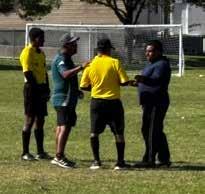
At the end of many games parents, coaches and players gather around officials to explain how they could do their jobs better. (Greg James/City Journals)
Senior Bridger Newsome focuses during recent action for the Mountain Ridge boys tennis team. (Photo courtesy Parker Hansen)
Matthias Newsome, a sophomore on the Mountain Ridge boys tennis team, is one of the doubles players for the Sentinels. (Photo courtesy Parker Hansen)
Chasing kids around the pitch is more difficult than it seems, but making perfect calls has become nearly impossible. Soccer referees ask youth associations to consider pay increases and sportsmanship improvements. (Greg James/City Journals)
Blueprints for the unthinkable: Inside Salt Lake County’s disaster doctrine
Salt Lake County ramps up emergency preparedness with community-driven planning.
By Shaun Delliskave s.delliskave@mycityjournals.com
Salt Lake County is reinforcing its emergency preparedness strategy with a comprehensive, coordinated, and community-centered approach to disaster readiness. Tina Brown of the Salt Lake County Emergency Management team provided an in-depth overview of the county’s current efforts, upcoming goals, and lessons learned from past disasters.
At the heart of the county’s preparedness efforts is the Comprehensive Emergency Management Plan (CEMP), which serves as the foundational document for all emergency response operations. “The CEMP is the base plan; the annexes cover specific types of disasters,” Brown explained. Complementing the CEMP are specialized plans, such as the Emergency Response Plan focused on hazardous materials and the Multi-Jurisdictional Hazard Mitigation Plan (MJHMP), which is currently under revision. “The MJHMP is updated every five years to reconsider whether the hazards are still appropriate, identify complete mitigation projects, and define new ones,” Brown said.
The updated MJHMP, once reviewed by the State Division of Emergency Management and FEMA, will help secure federal mitigation funding. “Some of our key takeaways from this update are the importance of ongoing coordination on mitigation activities,” Brown emphasized. “The value of continually engaging the community in understanding our hazards cannot be understated.”
One of the most pressing threats facing the county is the potential for a major earthquake along the Wasatch Fault. Brown noted, “According to the Utah and U.S. Geological Surveys, there’s a 57% chance of a magnitude 6.0 or greater earthquake along the Wasatch Front in the next 50 years.”
To prepare, the county is prioritizing planning, exercises like The Great Utah ShakeOut, and infrastructure retrofits. Residents are urged to build emergency kits, secure heavy furniture, and consider earthquake insurance. “The best time to prepare for a disaster is before it happens,” Brown stressed.
Communication and public engagement play a critical role in readiness. “We engage the community through multiple channels,” Brown said.
These include social media and the county website, where residents can access resources on emergency kits, communication plans, and hazard information. Brown added, “We encourage residents to get involved with their local emergency man-
agement office by attending preparedness events, trainings and community outreach activities.”
Salt Lake County also places a strong emphasis on interagency collaboration. “We activate the Emergency Coordination Center to unify efforts across jurisdictions and disciplines,” said Brown.
This central hub manages mutual aid and ensures that local needs are communicated to state and federal agencies. Partnerships extend to the Salt Lake County Healthcare Coalition, local city councils, and the Local Emergency Planning Committee, which meets regularly to align plans and conduct training.
Technology underpins much of the emergency management system. “We operate within a statewide interoperable radio network that allows emergency responders to coordinate across city and county lines,” Brown explained. Backup communication channels include amateur radio groups, and public alerts are delivered via Wireless Emergency Alerts, the Emergency Alert System, and social media.
Training is another key pillar. “We offer FEMA Incident Command System courses and run disaster exercises that test our plans in realistic, low-risk environments,” Brown said. These exercises are tailored to help participants—from local officials to volunteers—understand roles, improve response times, and identify areas for improvement.
Brown pointed to the COVID-19 pandemic as a catalyst for some of the department’s most significant recent changes. “One of the most important lessons was the importance of strong interagency coordination and communication,” she said. “The pandemic showed us that preparedness is not just about checklists—it’s about partnerships, relationships, adaptability and mutual trust.”
Looking ahead, Salt Lake County Emergency Management has set priorities focused on training, outreach and funding.
“Our greatest strength and capability is our people,” Brown said. “An informed community is a prepared community.”
The department also continues to pursue federal grant funding for vital resources, such as damage assessment tools and emergency shelter supplies.
Through what Brown calls a “whole community” approach—engaging non-profits, businesses and local groups—Salt Lake County is working to ensure its residents are ready for the unexpected. As Brown put it, “Effective mitigation strategies involve the whole community… We work together to become better prepared to respond and recover effectively.”
For more information on how to get involved or prepare for emergencies, residents can visit the Salt Lake County Emergency Management website at slcoem.org. l

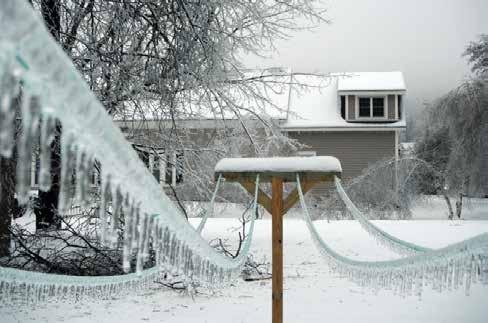
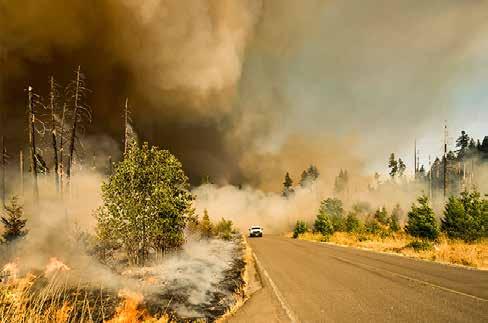
A 6.0 magnitude earthquake is forecasted to hit the Wasatch Front in the next 50 years. (Photo courtesy of SLCEM)
Winter weather provides multiple risks that Salt Lake County residents should prepare for. (Photo courtesy of SLCEM)
Wildfires not only are prone to Salt Lake County foothill areas but also freeway corridors and trailways. (Photo courtesy of SLCEM)
Gardner, Wittwer lead Mountain Ridge boys lacrosse to postseason win
The Mountain Ridge boys lacrosse team placed third in a competitive Region 2. The Sentinels then won their second-round playoff game to reach the quarterfinals.
By Josh McFadden
The fast-paced sport of lacrosse often features a lot of scoring and offensive fireworks, so it’s always helpful to have a strong defense. Lucky for the Mountain Ridge Sentinels, defense has been a strength.
The Sentinels went 3-2 in Region 2, placing third behind top-ranked Corner Canyon as well as Herriman. Overall, the Sentinels were 12-5 during the regular season. Mountain Ridge then defeated Lehi at home by the score of 6-5 in the second round of the Class 6A state tournament. Through 18 games, heading into the quarterfinals on May 17, Mountain Ridge had allowed 8.2 goals per game, a solid clip, especially considering the formidable foes the team faced.
The tough job of guarding the net this season belonged to senior Matthew Wittwer. This season, through the second-round victory, Wittwer had made 308 saves, a mark that was No. 1 in the entire state. Wittwer made more than 17 saves a contest.
When Wittwer talks about his experience on the team, he doesn’t mention personal stats or accomplishments. Instead, the humble goalkeeper is quick to praise his coaches and teammates.
“I love the culture we have established here at Mountain Ridge,” he said. “We
work hard and are always trying to win but then also having fun at the same time. Our coaches are amazing and are always pushing us but still let us have fun. That’s all I could ever ask for.”
Wittwer started playing lacrosse just four years ago as a freshman. It was an aunt (who had played lacrosse) who got him interested in picking up the sport. He loves the feeling of winning a game and seeing all his hard work pay off.
“The best part of competing is winning,” he said. “Victory is the end goal, and so we push ourselves to always get better and win as much as we can. I keep competing for the challenge of it. I might not win every game, but if I am challenging myself, then I will keep trying.”
In addition to stopping shots and being the most difficult goalie in the state to score on, Wittwer is a good leader. He has been an example for other players and is someone his teammates can rely on.
“One of my strengths is having empathy for the other players,” he said. “As a leader, it is my responsibility to help the members of my team, and having that connection with them makes that much easier. I am also very blessed to be athletic and to be able to keep up with everyone on the team even as a goalie. I tend to be a pretty intellectual guy and can learn things quickly and that too has helped me a lot in lacrosse.”
In his final season, Wittwer wanted to go out with a bang.
“As a senior, I am just trying to soak in every single moment of lacrosse that I have left and so I’m going to work hard to make sure we keep winning as many games as we can,” he said prior to the end of the
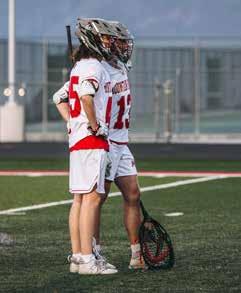
teammates.
“What I love most about competing is being able to push myself every game,” Gardner said. “I keep competing because I love the sport and the people I get to play with while also improving my abilities each day.”
As a fourth grader, Gardner had a friend who encouraged him to start playing lacrosse. The game appealed to Gardner and has been hooked ever since. Being a member of the Mountain Ridge team has been a memorable experience. He is grateful for his teammates and coaches, especially the passion and commitment they have for the game.
“I love our effort and energy,” he said. “As players we do our best to play hard and play the best we can. I also love our coaches coming into the program over the past two years and seeing our potential as a team and really pushing us toward that.”
season.
After graduation, Wittwer has big plans. He intends to serve a mission for The Church of Jesus Christ of Latter-day Saints and then attend Brigham Young University. Eventually, he wants to become an orthopedic surgeon.
Wittwer has plenty of help on defense to back him up.
Teammate Brody Gardner is a steady defender who makes Wittwer’s job easier. Gardner caused 20 turnovers and had 30 ground balls through the team’s regular season and first playoff game. The senior is a tough competitor who thrives on developing his skills and playing alongside his
Gardner is a strong one-on-one defender who possess good communication skills on the field. He understands his role on the team as well as the roles his teammates play. This season, Gardner has worked hard to improve his ground balls and transition play.
Like Wittwer, Gardner is a goal-oriented young man. He has set some clear objectives and knows what he’s after in life.
“My plans after high school are to go continue my academics and athletics at the University of Mount Olive in North Carolina,” he said. “I plan to get my pilot’s license and major in business out there as well as enjoying the next four years playing high-level lacrosse.” l
Fowlks caps high school career with solid senior season for Mountain Ridge baseball
Stockton Fowlks had a strong senior campaign for the Mountain Ridge baseball team. Fowlks helped lead his team to 16 regular-season victories and a win in the super regionals of the Class 6A state tournament.
By Josh McFadden
Mountain Ridge senior Stockton Fowlks has played baseball since before he started kindergarten. And though his high school career came to an end, he’s not finished with the sport yet.
Not by a long shot.
Fowlks and his Sentinels played admirably this season in a challenging Region 2, finishing 9-6 in league play, tied for third place with Bingham. Mountain Ridge was just a game behind region champions Riverton and Corner Canyon. The Sentinels went 16-9 overall during the regular season and grabbed the No. 4 seed in the Class 6A state tournament. At state, the Sentinels defeated Layton two games to one in the super regionals. Mountain Ridge won 5-0 on May 14 and then overcame a 6-4 loss
on May 15 to eliminate Layton in game three later that day by the score of 9-7.
Fowlks was brilliant in the clinching victory over Layton in the regionals.
In game three of the series, Fowlks filled up the stat sheet with a home run, a triple, a double and four RBI. His efforts in the victory were among his best of the season. Up to that point, heading into the team’s bracket-play game against region rival Riverton on May 19, Fowlks had totaled a home run, a triple, 10 doubles and 15 RBI. As a junior, the standout recorded six home runs, two triples, 13 doubles and 29 RBI. Fowlks was productive as a sophomore too. That season, he hit a home run and a triple as well as 10 doubles and 15 RBI.
Soon, he’ll take his talents to the next level. Fowlks will attend the College of Southern Idaho in Twin Falls after high school to continue his baseball career at the two-year institution.
“I hope to have a very successful college career and play baseball at a high level for a long time,” he said.
Fowlks began his baseball journey 14 years ago when his father, who had played baseball for several years in his youth, signed him up to play t-ball.

“I have been in love with [baseball] ever since,” Fowlks said.
Some athletes—maybe many—struggle to perform when expectations are high and when the challenges are big. However, Fowlks said he thrives in these situa -
Matthew Wittwer (on the right with the stick) and Brody Gardner are two big reasons why the Mountain Ridge lacrosse team has had one of the top defenses in Class 6A this season. (Photo courtesy Justin Rigby)
Mountain Ridge’s Stockton Fowlks, shown here at the plate against Herriman this past season, will be off to the College of Southern Idaho to play at the next level. (Photo courtesy Shelly Swain)
tions. He has found a lot of satisfaction in playing baseball because it gives him the chance to set and achieve goals.
“I enjoy the pressure that comes with competing and being able to step up in those big moments,” he said. “I love the feeling of accomplishing what you’ve been working so hard for. It’s what keeps me coming back every time.”
Though even bigger challenges and opportunities await Fowlks as he prepares to play in college, he’ll always be grateful for his time at Mountain Ridge.
“The games are always super fun with your team cheering you on, but hanging out with each other outside of baseball is my favorite time,” he said. “Being able to create a brotherhood with every person on the team is what is special to me.”
Mountain Ridge head coach Brock Whitney has relied on Fowlks for both his production and leadership. Fowlks is a dependable hitter, but he also has been a good example for his teammates.
“My strengths in baseball are hitting and being a leader on my team,” he said. “I love being able to get a great hit and put my team in a position to have success. And also, my strength is teaching the younger guys skills to keep the winning culture throughout the team.”
During Fowlks’ career at Mountain Ridge, the Sentinels had a combined re -
cord of 70-46. Mountain Ridge had winning records (and at least 18 victories) in his final three seasons. Though he had had success and achieved accolades, Fowlks is not complacent.
“I want to improve on getting bigger and stronger every year,” he said. “There is no better feeling than seeing all of your hard work you have put in pay off and seeing yourself become a better player because of it. Individually, I want to become the best player I can be.”
Like other sports, baseball requires more than physical tools to be successful. Fowlks understands this and knows his mental strength will help him to be a good teammate and key contributor at the college level.
“The most challenging part is having a strong mental game,” he said. “Mentality is huge and being able to stay positive every day, and giving yourself the confidence to be the best is a massive part in being successful. Striking out or making an error can be hard on you mentally and you have to learn how to bounce back and move on.”
Fowlks’ presence will be missed in the Sentinels’ lineup in 2026. He left his mark on the program—a program that Fowlks hopes will continue to be a factor in the region and state race for years to come. l
OPEN HOUSE
JOIN
US!
Saturday, June 21 9:00 a.m. – 12:00 p.m.
4763 W Salish Circle Riverton, UT (801) 599-3459
(Se habla español)
We’re inviting families to come and see a safe, loving space where their children can grow, learn, and thrive.
During the event, families will have the chance to:
• Tour the center
• Meet the staff

• Ask questions and learn more about our program
• Light refreshments, hands-on stations, and a warm welcome to our community!
Parents and children welcome!

For children ages 6 weeks to 5 years.

Pitcher and leader: Riding helps Mountain Ridge baseball to high ranking in Class 6A
Grayson Riding helped lead the Mountain Ridge baseball team to the No. 4 seed in the state playoffs.
By Josh McFadden
If you were to make a list of the most difficult, important positions in sports, a baseball pitcher would have to be near the top. Luckily for the Mountain Ridge Sentinels, they had a stellar player filling the position.
Mountain Ridge senior Grayson Riding sent away 42 batters this season, making him a difficult pitcher to hit against. Riding had 16 strikeouts a year ago as a junior while compiling a 3-0 record. His efforts helped the Sentinels go 16-9 during the regular season and tie for third place in a challenging Region 2.
“Grayson has been great for us, leading us on the mound,” head coach Brock Whitney said. “His leadership at practices and games, along with our other seniors, has been the biggest thing that I have noticed between years past and this year. He has embraced that role as well. It has been fun to watch how he has improved over the years, as he is a multiple-year contributor and has proven that hard work pays off.”
Like his teammate Stockton Fowlks, Riding will take his talents to the College of
Southern Idaho in Twin Falls next season to play at the next level. Riding loved his time on the Mountain Ridge team and will always be appreciative for the experiences he had as a Sentinel.
“We have a very competitive team where winning is important to all of us,” he said. “We all work together, and you truly never know who is going to step up in any game. It’s really fun to be a part of.”
Riding started playing baseball at the young age of 4. As a child, he spent a lot of time playing catch with his father, a person whose love for baseball rubbed off on his son.
“I instantly fell in love with the game,” Riding said.
By age 7, he was on a competitive team, the Utah Marshals. At age 14, he joined Mountain West Academy where he continued to hone his skills.
Baseball has offered Riding a healthy outlet, he said. He loves the emotions of the game and being able to compete on a big stage. He has never shied away from facing a difficult opponent or confronting a daunting situation, even when the stakes were high.
“I love the adrenaline rush and the pressure that competition gives me,” he said. “I truly love this game and I can’t imagine not playing. High-level competition gives me an opportunity to level up my game. I am constantly trying to find different ways to become
more successful than my last outing.”
Riding said he has a strong work ethic and does what it takes to get better and be successful. Whether it’s at a game or practice, he’s determined to do things right and always be at his best.
Going forward, Riding is determined to develop his game even more and get better about the mental side of competing. He has put a lot of focus on having a good mindset and perspective.
“I want to improve my mental game,” he said. “I am hard on myself and over-analyze things. The mental side has always been a challenge for me and comparing myself to other athletes. As athletes, many of us expect perfection out of ourselves in a game that breeds failure. This year, I’ve done a lot of work to stay mentally strong and only compete against myself for my personal gains.”
In the Region 2 standings, Mountain Ridge finished tied for third in a close race. The Sentinels were 9-6 in league play in what was a close race between four teams at the top. Though Mountain Ridge lost six region games, every defeat was close, never losing by more than two runs. On the other hand, Mountain Ridge had its share of close victories, too. The Sentinels had seven wins in region action by a single run and another victory by two runs, proving that the team was good in the clutch.
Riding and his teammates were good

defensively, only allowing two region foes to score more than nine runs in a game. As of May 17, the 18-10 Sentinels had allowed a total of 140 runs, an average of just five runs surrendered per game.
After graduation, Riding is grateful that he’ll have the chance to not only continue his baseball career but to further his education. The fact that he’ll get to play with his longtime teammate Fowlks is a bonus. l
New tool at Intermountain Riverton Hospital aims to tackle allergy season
Data from the spore collector can help doctors treat allergy patients more effectively.
By Peri Kinder
peri.k@thecityjournals.com
With spring comes seasonal allergies, causing itchy eyes, runny noses, constant sneezing and the search for relief. Intermountain Riverton Hospital is stepping in with a fresh approach: the Burkard pollen and spore collector.
The device sits on the hospital’s roof where it gathers mold scores and pollen counts. That information is then processed by looking under a microscope to observe and interpret which pollen count is high on any given day. The data will help patients and doctors work to improve the way allergies are triggered and treated.
Dr. Scott Taylor, an allergist at the Intermountain Riverton Southridge Allergy Clinic (3723 W. 12600 South), said while the device isn’t new, it’s the first Burkard collector on the south side of Salt Lake County.
“We got certified as a National Allergy Bureau investigation site, so it’s kind of exciting,” Taylor said. “The Burkard spore collector has been around since the 1950s but it’s improved over the years. It also helps people who have asthma, which can be triggered by pollen, as well.”
Once data is collected, patients can go online to see pollen counts and will have a better idea of how to create specific treatment plans with their allergists. Daily pollen counts are posted at Intermountainhealthcare.org/locations/southridge-clinic/allergy.
“Patients are noticing every year that they have similar
symptoms around the same range of time,” Taylor said. “It’s important to meet with an allergist, to get good testing done and get treatment for their symptoms.”
Taylor said there are about 20 top allergens in the Salt Lake Valley, depending on the time of the year. Tree pollens come out in the spring, grass pollens in the summer and ragweed in the fall. During the winter, allergies tend to come from being inside with pets. The Burkard, or the Big Green, as Taylor called it, is turned off during the colder months.
South Jordan resident Julia Jones has worked with Taylor for the last decade, finding relief for her daughter who suffers from extreme allergy symptoms including the swelling of her ears and eye lining. Jones also developed allergies a few years ago and is careful to create a home environment that fosters clean air.
“It used to be we couldn’t use the swamp cooler in our house, just [air-conditioning] only, which is much more expensive and the windows were shut all the time. There were days when there was no going outside at all,” Jones said. “Now, as allergy shot patients, we can look on the website and see specifically what we’re reacting to on which days. So say I’m having a lot of symptoms, maybe it shows the ash tree is high. Then [the allergist] can take that information and increase the amount of ash in my serum that they’ll use for my allergy shots.”
Jones can also take the daily pollen count and adjust behaviors. For instance, if ragweed counts are high, she’ll wear eyeglasses instead of contacts because she knows her eyes will be itchy and watery all day. She can also take higher doses of antihistamines or talk to her doctor about treatments that bring long-lasting relief.
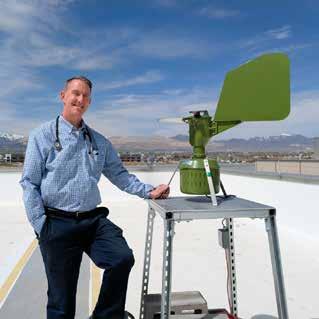
“It’s not this major trial for most people, but it is annoying. It’s irritating to have these symptoms and when you see the blossoms on the trees, you know symptoms are coming,” she said. “It’s a blessing to have tools like this device that we can check online and that we have immunotherapy to help us improve our symptoms, if not help them disappear altogether.” l
Senior Grayson Riding was a dependable pitcher this season for the Mountain Ridge baseball team. Riding led his team to 16 wins in the regular season and picked up a win in the super regionals. (Photo courtesy Shelly Swain)
Allergist Scott Taylor, MD, stands by the Burkard spore collector, a machine at Intermountain Riverton Hospital that will help track pollen counts in the South Valley area. (Peri Kinder/City Journals)

Interfaith gathering celebrates Christian love at South Jordan event
A pre-Easter event at The Ballpark at America First Square celebrated the messages of Jesus Christ with song, artwork and food.
By Tom Haraldsen t.haraldsen@mycityjournals.com
The South Valley Interfaith Council held a pre-Easter event on April 14 at The Ballpark at America First Square. Several thousand people attended the gathering, which included musical performances, an art show, a wall of testimonies from residents about their feelings on Jesus Christ and booths/exhibits from several religious congregations in the Salt Lake Valley.
Headlining the performances was musical group J209, who took the stage set up in the infield of the ballpark, home of the Salt Lake Bees. Lead signer Abi Urton said her group’s mission, like those of all the performers, was one of unity.
“We realized that there’s been a lot of tension between different religions for decades and centuries, but what we ultimately all try to do is grow closer to Jesus Christ, even from different paths, so we’re better prepared for His coming,” she said. “There’s been a decline in church attendance, especially in groups of those 20 to 30 years old, so our whole mission is to create an environment where people can find a community that supports their faith.”
A committee made up of members of The Church of Jesus Christ of Latter-day Saints, Neighborhood Church, Sego
Church of South Jordan, the “Hello Saints” YouTube channel and Multiply Goodness worked together to host the event.
“We knew about the concept for the program in January,” Urton said. “Several different pastors knew about us, which surprised us since we had just started performing then. We all began working together to put on the event.”
Bethany Zeyer, a member of the Interfaith Council, said it was a great opportunity for different denominations to share traditions and their messages. There were 14 stations set up in and around the stadium where groups could share their thoughts as the Easter season approached. Several of the food vendors at the stadium were also open for business to feed families who attended.
The story of J209 is one of combined spiritual commitment, with members coming from different backgrounds to form a vocal band that has performed at many events the past few months, and will be touring into southern states later this year.
“Our name came from my own spiritual journey of sorts,” Urton said. “I came across Jeremiah 20:09 in the Bible that talks of an internal struggle.” She said her journey to strengthen her beliefs was heightened by the verse that speaks of an inner fire of the need to share God’s word, despite struggles and challenges. That sharing “is what our message is all about.”






She also loved the efforts of these different denominations coming together to “find God and trying to be closer to Jesus Christ. It felt amazing.” l








Volunteers from several community churches manned displays and answered questions at the Interfaith event. (Tom Haraldsen/City Journals)
By Holly Curby hello@hollycurby.com
AsBuilding confidence and mental wellness
spring blooms, so too does the season for self-reflection and growth. It’s a time to take the opportunity to think about the various roles we take on in life and the ways we view ourselves. This reflection, however, often leads to an uncomfortable truth for many of us: we can be our harshest critics. Whether we’re thinking about our careers, relationships or personal goals, how often do we find ourselves doubting our worth or feeling like we're just not measuring up?
It’s something that’s far more common than we might like to admit. The root of this thinking often comes down to our confidence – something many of us struggle with from time to time. The truth is, unshakable confidence doesn’t come naturally to most of us. We all face moments when we feel less than "enough." But as former first lady Eleanor Roosevelt wisely said, "No one can make you feel inferior without your consent."
Through personal experience, I’ve noticed a few common themes that tend to crop up, and I’m sure many of you can relate. Here are some of the most frequent struggles that impact our sense of confidence and mental wellness:
1. Imposter Syndrome
Have you ever felt like you don’t belong, despite your qualifications or experience? It doesn’t matter if you have all the credentials, the knowledge or the background; at times, you might still feel like you're just not good enough to be at the table. This can happen in any role – whether you’re stepping into a leadership position, a new job or even in your personal relationships. The feelings of self-doubt are real and can be difficult to shake. Imposter syndrome often feeds into our mental wellness, triggering feelings of anxiety and stress that affect our overall sense of well-being.
2. The Comparison Trap
I’m sure you’ve walked into a room and noticed someone and thought, "Wow, they’ve got it all together. Why don’t I?" This could be someone in your gym class, at work or even in your social circle. We might see someone who's more successful, more put-together or simply appears to have the "perfect" life. Suddenly, our own confidence plummets. Or, even worse, we might make ourselves feel better by comparing ourselves to others in a way that diminishes their worth. The constant cycle of comparison can quickly rob us of joy and self-esteem, often contributing to stress and burnout, which have a direct impact on mental wellness.
3. Feeling Stuck
There are times in life when we feel trapped – like we're standing still while everyone else is moving forward. Whether it’s

because you’re at a crossroads in your career, facing burnout or feeling trapped in a difficult situation (like a toxic relationship or financial struggles), the weight of stagnation can be a serious blow to our confidence and mental wellness. The longer we feel stuck, the more our sense of self-worth can erode, and the harder it becomes to move forward.
Now, I’ll be the first to admit that I am no expert on confidence or mental wellness, but I’ve learned a few things along the way that have helped me when I’m feeling less than "enough." Here are 10 tips that I’ve found helpful in building back my confidence and nurturing my mental wellness during those tough times:
1. Escape to Your Happy Place
There’s something incredibly powerful about getting away to a space where you feel safe and inspired. For me, it’s our family cabin or at a local café. Sometimes all it takes is a change of environment to reset your mindset. It could be as simple as going for a walk, visiting a peaceful park or taking a moment to sit somewhere where you can clear your head. A change of scenery can be incredibly beneficial for mental wellness, helping you manage stress, regain clarity and reconnect with yourself.
2. Evaluate Your Social Circle
The people we surround ourselves with play a huge role in how we feel about ourselves. As the saying goes, "Bad company corrupts good character." It’s essential to have a support system of people who build you up, challenge you to be your best and align with your values. If you find yourself surrounded by individuals who drain your energy or constantly make you question your worth, it might be time to set boundaries or distance yourself. On the other hand, make an effort to spend more time with those who encourage and uplift you. A healthy, supportive social circle is crucial for nurturing mental wellness.
3. Commit to Growth
One of the greatest sources of insecurity can come from feeling like you don’t know enough. The key is to adopt a growth mind-
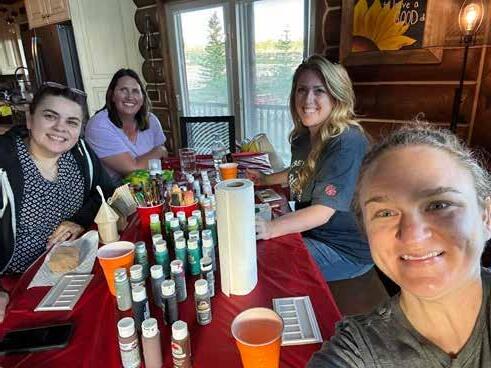
set. Never stop learning. Read books, listen to podcasts, attend workshops or seek out mentorship. Put yourself in environments where you are challenged and can learn from others. Make intentional strides to be better every day. By focusing on growth rather than perfection, you reduce the pressure you place on yourself, which contributes to improved mental wellness.
4. Watch Your Self-Talk
Our thoughts shape our reality. If you're constantly telling yourself that you're not good enough, not capable or not worthy, then that becomes your truth. Shift your self-talk to reflect positivity and reality. For example, instead of thinking, “I can’t do this,” reframe it to, “I might not know how to do this yet, but I will figure it out.” Replace negative self-talk with affirmations that reflect your strength and worth. Positive self-talk can reduce anxiety, improve your mental outlook and boost your overall well-being. I often ask myself, “would I speak to one of my kids this way?” If not, why would I speak to myself in such a way either?
5. Understand Your Value
It’s easy to place your value in external sources like the approval of others, your achievements or even social media validation. But the truth is, your worth is intrinsic. It doesn't depend on likes, followers or anyone else’s opinion of you. Your value comes from within and is not contingent on external circumstances. Remind yourself daily that you are enough, just as you are. This understanding is fundamental to maintaining healthy mental wellness because it frees you from external validation.
6. Be True to Yourself
There’s only one you, and that uniqueness is your superpower. Stay true to your values and priorities. It can be tempting to try to fit in or cater to what others think is best for you, but you will never be fully confident when you're compromising who you are. Know your values, your passions and your goals – and pursue them authentically, even if it means saying no to things that don't align with your true self. Mental wellness thrives when we honor our authentic selves and set boundaries that protect our energy.
7. Pursue What Interests You
Engaging in activities that bring you joy and fulfillment can have an incredible impact on your confidence and mental health. Whether it’s a hobby, a sport or even a new project, the act of doing something you’re passionate about helps build self-esteem and promotes mental wellness. Invest time in what excites and motivates you – whether that’s taking up a new skill, revisiting an old hobby or simply doing something that makes you feel good.
8. Refresh and Recharge
Self-care is essential to maintaining confidence and mental wellness. Taking care of your mind and body helps you feel your best. Whether it’s getting a massage, exercising, meditating or simply enjoying a quiet moment, find ways to refresh and rejuvenate. Don’t underestimate the power of taking a break to recharge your batteries. Regular rest is necessary for mental health, reducing stress and restoring your emotional equilibrium.
9. Count Your Blessings
Gratitude is one of the best ways to shift
Surrounded by friends, we find support and strength, boosting our confidence and mental wellness. (Photo courtesy of Jessica Grennan)
your perspective and boost your confidence. Take time each day to reflect on what’s going well in your life. When you start counting your blessings, you realize just how much you have to be grateful for – and that can give you the confidence you need to face any challenge. Practicing gratitude also promotes mental wellness by helping you focus on the positives rather than dwelling on the negatives. 10. Know When to Ask for Help
No one can do it all alone. We often think others will see our asking for help as a weakness or inability to do something, but asking for help is often the greatest act of strength. Whether it’s hiring a coach, seeking support from a mentor or even seeing a counselor during difficult times, don’t be afraid to lean on others. Asking for help doesn’t make you weak – it makes you wise. Mental wellness is supported by seeking professional guidance when needed and leaning on trusted loved ones for support.
After reading through these tips, ask yourself: Where is your biggest confidence or mental wellness struggle? Why do you think it’s a struggle for you? And most importantly, what steps can you take to work on that area? Don’t be afraid to share your journey with others for accountability and support. Confidence and mental wellness don’t come overnight –they’re ongoing processes. For more tips and insights check out Holly’s Highlights podcast available wherever you listen to podcasts as well as on www.hollycurby.com.
Through life's ups and downs, it’s import-

ant to remember that confidence and mental wellness are journeys. Whether you're facing a new challenge, going through a transition or simply trying to find your footing, both will grow with patience, practice and perseverance. In the words of actress and model Blake Lively, "The most beautiful thing you can wear is confidence." So, go out there and wear it proudly, knowing that your mental wellness is just as important as your outward confidence.l



We are the bridge between businesses and the community in Blu dale, Herriman, and Riverton.
At The Station, we believe in celebrating life with great food, amazing drinks, and even better company. Our bar is more than just a place to grab a drink—it’s a community hub where everyone feels at home. They are located 12283 Herriman Main St. and open for lunch and dinner. Boosting Local Business Traffic
Mountain West Chamber of Commerce is excited to launch a new marketing program called Local Link. This program aims to increase foot tra c to local businesses using an app called Goosechase. Businesses can sign up to be a “destination” on the app and o er a unique experience or discount, known as a “mission,” to customers who visit their location. Potential customers can download the app for free, complete missions, and earn points. The customer with the most points at the end of each month wins a prize.
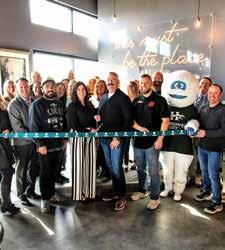












A stroll through Thanksgiving Point gardens reminds us confidence and wellness grow with care. (Photo courtesy of Holly Curby)
Utah’s Wasatch Front is growing faster than almost any other region in the nation, and nowhere is that more evident than here in Salt Lake County. Today, more than 2.8 million Utahns—over 80% of our state’s population—live along the Wasatch Front and Back. By 2050, we’re on track to nearly double that number, reaching around 5 million Utahns. Protecting the quality of life that drew families, businesses and adventurers to our valleys and mountains in the first place means making smart, coordinated choices right now.
Utah was recently recognized as the best state in the nation by U.S. News & World Report for the third consecutive year. While we have so many great things going for us—a strong economy, volunteerism, social capital and incredible people—one of the things that helps with our success is our willingness to work together.
When it comes to planning for the future, it’s vital that we collaborate at each level of government. I’m proud to be a board member for a planning body that does just this. Wasatch Front Regional Council (WFRC) brings together elected leaders and staff from the state, counties and cities across our region. WFRC ensures that transportation investments, land-use decisions and economic development strategies all align with a shared vision—what we call the Wasatch Choice Vision.
The Wasatch Choice Vision is organized around four key strategies:
1. Real Transportation Choices - Expand travel options beyond the single-occupancy vehicle. By investing in transit, bike networks, sidewalks and more efficient roadways, we help everyone—from commuters to families running errands—get where they need to go safely and affordably.


2. Housing Options for All - Encourage development patterns and zoning that support a wide range of housing types—single-family neighborhoods, starter homes, workforce apartments and townhomes—so that people at every stage of life can find a place to call home that’s close enough to jobs, schools and services.
3. Plentiful Parks and Open Spaces - Preserve and enhance parks, trails and open land for recreation, environmental protection and community gathering. These green assets keep our air and water clean, support mental and physical health, and maintain the outdoor lifestyle Utahns cherish.
4. Vibrant City and Town Centers - Strengthen walkable downtowns and neighborhood hubs where people can live, work, shop and play. By focusing growth in these centers, we relieve pressure on suburban and rural areas, reduce drive times and foster stronger social connections.
No two communities are identical. What succeeds in Sandy or South Jordan might look different than what works in Murray or West Valley City. That’s why WFRC’s member jurisdictions—from the state Department of Transportation to Salt Lake County and its constituent cities—work side by side to adapt the Wasatch Choice Vision’s strategies to local circumstances, ensuring each community charts its own course while staying connected to its neighbors.
Putting the Wasatch Choice Vision into action will have concrete impacts right away—and pay dividends for decades: more jobs, conserved open space, less water used, billions saved in infrastructure costs, and reduced household budgets through more housing and transportation options. This translates to stronger communities, healthier families and a sustainable economy that can thrive even as we welcome more neighbors—along with our children and grandchildren—to our mountain valleys.
None of this would be possible without the active partnership of the state, county planning commissions, city councils, transit agencies, business associations and civic groups. Through WFRC, these diverse interests come together at the same table—an inclusive forum where big-picture goals align with local aspirations.
I’d encourage you to learn more about the Wasatch Choice Vision. Our region’s future quality of life depends on informed, engaged residents—and on leaders who listen, collaborate and act. Visit wfrc.org to see the Vision and learn more about how to stay informed. l








































A Puppet Regime
It took decades, but Ronald Grump finally found a way to evict the residents of 123 Sesame Street. Grump (played by Joe Pesci) visited the TV show in 1994 with plans to demolish the beloved neighborhood to build Grump Tower.
Sesame Street doubled-down in 2005 when a selfish, orange-haired muppet, Donald Grump, tried to hire an apprentice to help with his trash empire. In the episode, Oscar the Grouch sings about Grump, “Whose name equals trash, to you and to me?”
Maybe he holds a grudge, but a U.S. president with a similar name signed an executive order to cut funding for PBS, a nonprofit provider of educational shows like Arthur, Elmo’s World and Sesame Street.
The move could throw the Muppets into the gutter. Bert will have to sell his paper clip collection, Elmo will be forced to pawn his tricycle and Count von Count will have to join an accounting firm.
From the beginning, Sesame Street championed diversity, equality and inclusion: three things the current administration is gleefully destroying. Humans on the show included Gordon and Susan (a Black couple), Maria from Puerto Rico, Luis from Mexico and the elderly Mr. Hooper, who was Jewish and ran the corner store.
The multicultural cast attracted big guest stars. Carol Burnett, Stephen Curry,
Peri Kinder Life and Laughter

Robert De Niro, Billie Eilish and James Earl Jones are just a few celebrities who visited Sesame Street, proving you’re never too famous to be silly.
Not only does the show teach children basic reading and math, it also teaches cooperation, respect and kindness. It’s tackled divorce, same-sex marriage, racial literacy, anger, sadness and even has a Muppet whose parent is incarcerated. The show never talks down to children.
When Will Lee died, his Mr. Hooper character died with him, leaving Big Bird distraught as his friends tried to explain the concept of death. That episode won an Emmy, one of more than 120 Sesame Street has collected.
Sesame Street has its furry finger on the pulse of American culture. The show is as much for parents as for kids. My favorite characters are the loveable Grover and Guy Smiley, the enthusiastic gameshow host.
I can still sing the show’s theme song,

along with “Rubber Duckie,” “I Love Trash,” “Doin’ the Piegeon” and hundreds of tunes from the show. I couldn’t begin to choose a favorite skit but I always loved the baker falling down the stairs. That remains my level of humor maturity.
The show is iconic. Big Bird is an international star. He visited Michelle Obama at the White House, made the cover of Time magazine, has a star on Hollywood’s Walk of Fame and his picture on a postage stamp. I spent several months cross-stitching Big Bird’s face on a Christmas advent calendar our family still uses nearly 40 years later.
Maybe it’s because Muppets don’t vote. Maybe it’s because Oscar started teaching kids about recycling. Maybe it’s the Sesame Workshop’s mission statement, “Helping


children everywhere grow smarter, stronger, and kinder.” Maybe the president just doesn’t like watching people have fun. My husband and I paid thousands of dollars in federal taxes this year, but if funding is cut for things I value, like PBS, science, national parks, higher education, Head Start programs and world health initiatives, maybe I don’t have to pay taxes anymore. I mean, seeing all these tax-free billionaires… tax evasion isn’t a crime anymore, right?
Sesame Street promotes kindness and community, while the president seems to only find value in wealth and power. As he said in 2011, “Part of the beauty of me is that I am very rich.” For anyone who’s ever loved Sesame Street, beauty has a much deeper meaning.






